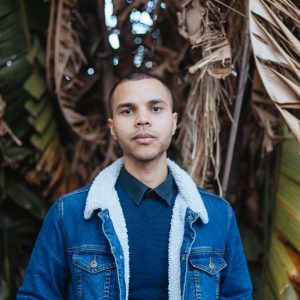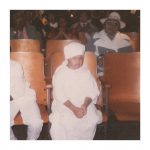Farewell, saxophonist great Manu Dibango
The work of the jazz artist who died after contracting Covid-19 established a lingua franca for modern African popular music.
Author:
27 March 2020

“I have always been the product of mixtures, from the beginning,” declared musician Manu Dibango late last year.
Innovative sonic blends, alongside superb musicianship, were what made the work of Emmanuel “Manu” N’Djoke Dibango, who died aged 86 on 24 March 2020 as a result of Covid-19, so remarkable. And yet that hybridity was often misunderstood.
Many obituary writers couldn’t resist the cliche of “mixing modern and African sounds”. Dibango scornfully dismissed such superimpositions as “collage”: “making jazz and sticking it on to an Afro thing. It’s not about that. It has to melt into it, becoming natural. That’s the difference.”
But his interview allusion to mixtures wasn’t only a musical one.
Related article:
Dibango was born on 10 February 1934 just outside Cameroon’s capital, Douala, almost at the foot of Mount Cameroon. His parents were Protestants, but from different denominations. His dressmaker mother came from the Douala people while his civil servant father came from the Yabassi.
He grew up predominantly with the music of the church – one uncle played harmonium – and French pop on the radio. Another uncle was a traditional guitarist, but Dibango’s father shunned him: “It was the music of the devil.”
When he was 15, Dibango attended boarding school in France – a three-week sea journey – to complete his baccalaureate. When I interviewed him in 2002 in Johannesburg over Parisian quantities of extremely strong black coffee – he was here for the Arts Alive festival – he said they had hoped he would eventually study medicine.
Dibango arrived in France with a gift for his French hosts: three kilos of coffee. (This was post-war France and real coffee was a luxury.) The incident gave him the title for his 1994 autobiography.
The birth of a musical career
By 18, Dibango on mandolin had teamed up with fellow Cameroonian and guitarist Francis Bebey for school summer-camp jams. He was starting to haunt record stores and jazz clubs whenever he could escape. Dibango learned piano, and then another friend, Moybe Ndedi, gave him a beat-up old saxophone to practice on. Vibraphone came a bit later.
Fast forward to 1956, and Dibango had quit his studies and was performing full time and with some success, gravely disappointing his parents. He moved to Brussels, found plentiful cabaret work, and married Marie-Josée (Coco), a white Belgian woman. His parents cut him off.
He was still in Brussels at the time of the 1960 Belgo-Congolese Round Table independence conference – to which popular leader Patrice Lumumba had brought a team of cultural workers as well as politicians: the “African Jazz” orchestra of Joseph Kabasele (Le Grand Kalle).
Related article:
“Lumumba was the artists’ favourite … to recruit an orchestra at the same time as discussing the destiny of a country is pretty special,” reflected Dibango. Kabasele found himself short a sax player, and snatched the now highly admired Dibango to fill in on what became some legendary recording sessions, and then returned with him to Leopoldville (later Kinshasa).
That ensured Dibango’s fame across Africa: Congo had the most professionalised music scene on the continent and a radio station that beamed the saxophonist’s 1962 Twist to Leo continent wide. But “When you come from Duke Elllington and Count Basie and you are only able to play dance music, it fucks with you.” So the bored Dibango opened a club, Tam-Tam, then a second in Douala. He returned to France when civil war made conditions difficult.
Soul Makossa’s success
Extensive club and television work and a first album followed. And then, in 1972, Dibango won a contest to compose the official Africa Cup of Nations anthem for the Indomitable Lions. That song is long forgotten – but the B side of the 45 rpm record was a number called Soul Makossa with a compelling rhythm feel. “There were no drum machines at that time. [We doubled the bass and drum lines] because we could not record the counter time that I wanted.”
Rather like the “discovery” of Africa, more than a year before New York DJ David Mancuso allegedly “discovered” the track, African football and music fans across the continent had made it a hit.
“Makossa’s not a traditional rhythm,” Dibango said. “It’s urban music with influences from Nigeria, Zaire and so forth. Add in the Cameroonian personality, the kinds of Protestant church vocal harmonies which link us to Ghana and Kenya, all those common roots … but then again, Soul Makossa is my view: something else again.”
By the following year Soul Makossa was in the Billboard Top 40. Motown and Atlantic labels vied to release a complete album. Dibango opted for Altlantic because “they had Ray Charles and Aretha Franklin … much closer to my sensibilities”.
After that, Dibango’s career soared. Discographical websites credit him with at least 197 albums. He spent time in Ivory Coast and the Central African Republic as well as Congo and Cameroon. His base in Paris was the launching pad for multiple international tours. He worked with Herbie Hancock, Ladysmith Black Mambazo, Sly and Robbie in Jamaica and a panoply of West African music stars. He also successfully sued both Michael Jackson and Rihanna for ripping off the Soul Makossa chorus – the Jackson out-of-court settlement was rumoured to top two million francs.
Intelligence, wit, grace and warmth
Every journalist who interviewed Dibango came away impressed by his terrifyingly sharp intelligence, expressed with wit, grace and warmth. He was neither falsely modest nor arrogant: his music was what it was. And that takes us back to what, irrespective of commercial success, made it – and him – so profoundly important.
Dibango sometimes resisted the “Afro-jazz” label imposed on his music. He adored playing and collecting jazz – “It’s the beautiful flower that has struggled up to blossom out of those centuries of oppression” – but it was not his mission.
Rather, his work established a lingua franca for modern African popular music.
Related article:
Soul Makossa is like something from Shakespeare: everybody – not just Jackson and Rihanna – (mis)quotes it. His sax asserted Afro-futurism against what he dismissed as “ethno-purity”, deploring that Africa too often “came to the world through its past, not its present”. Instead, “there is an electric Africa … our music isn’t going to be in museums any more”.
That electric Africa was inextricably woven with dance – “We mustn’t forget that Duke [Ellington] and the others played clever music that people still loved to dance to” – and gently subversive in its broad embrace. “I’m a breaker of classifications,” he said 18 years ago. “I have my own personal melting pot in my head.”
Rest in peace to a giant.
Six of the best: a Manu Dibango playlist
1962: Twist à Leo
The Twist was high fashion in the early 1960s and Dibango was the first African-continent musician to play it. Recorded in Leopoldville: “I was like a journalist; I seized the air time.”
1969: Paris and a cover of (white singer) Nino Rossi’s I Want to be Black. Dibango observed dryly, “It was done on purpose, of course, for those who understand layers of irony.”
1972: The original Soul Makossa.
1973: Performing the song live on French TV.
1978: Reggae Makossa with the Brecker Brothers, Sly Dunbar and Robbie Shakespeare. Kingston remix with Dibango on vibes.
1984: Another international hit, Abele Dance.
1994: Imbube with Ladysmith Black Mambazo on Waka’frika.
2017: Manu Dibango and Mozambican reedman Moriera Chonguica performing Zacks Nkosi’s Nonto Sangoma at the Cape Town International Jazz Festival.



